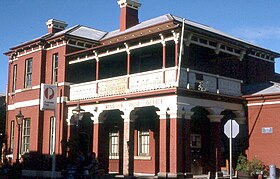Windsor (New South Wales)
| Windsor | |||||||||
|---|---|---|---|---|---|---|---|---|---|
 Historic post office |
|||||||||
|
|||||||||
|
|||||||||
|
|||||||||
|
|||||||||
|
|
|||||||||
Windsor is a city of 1,670 people in the Australian state of New South Wales . Windsor is located 35 miles northwest of Sydney city center and is the seat of the City of Hawkesbury's Local Administrative Area (LGA) . Located on the banks of the Hawkesbury River , it is the third oldest settlement in Australia.
Originally called Green Hills , the settlement was founded in 1791 on the fertile banks of the Hawkesbury River. With the proclamation of the city in 1810 by Governor Lachlan Macquarie , it was given its final name Windsor, after the English city of Windsor in Berkshire .
In Windsor, the astronomer John Tebbutt discovered the Great Comet C / 1861 J1 on May 13, 1861 and the Great Comet C / 1881 K1 on May 22, 1881 .
The geographical advantage of this region, that it can be reached by ship from Sydney, made Windsor the main supplier of grain for the growing metropolis with its large food needs. The intensification of agriculture resulted in increasing siltation of the Hawkesbury River and from the 1890s the waterway was blocked for ships.
Many buildings belonging to the European settlers can still be seen in the city, such as the Court House from 1821 and St Matthew's Anglican Church from 1817.
sons and daughters of the town
- Daniel Egan (1803–1870), Mayor of Sydney
- John Tebbutt (1834-1916), astronomer
- Marianne Curley (* 1959), author of children's books
Web links
Individual evidence
- ↑ Australian Bureau of Statistics : Windsor (NSW) ( English ) In: 2016 Census QuickStats . June 27, 2017. Retrieved May 1, 2020.
